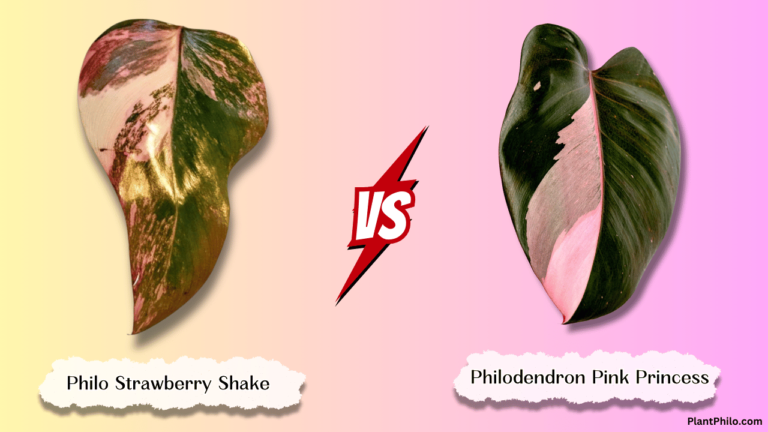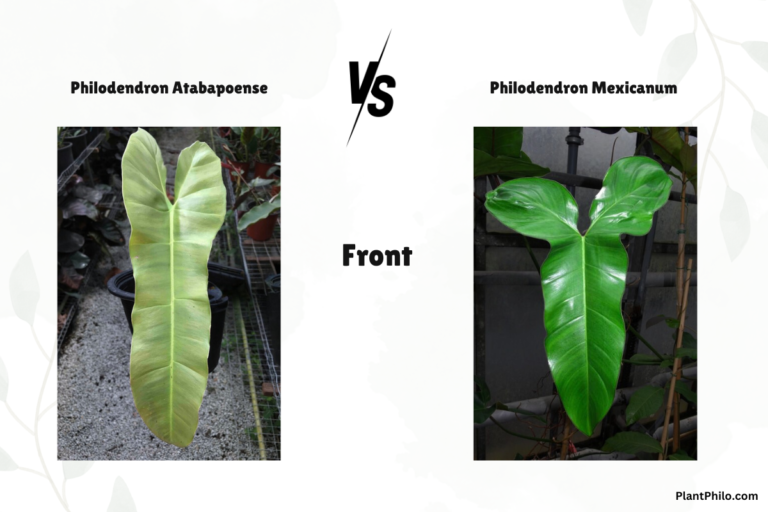Misidentified Plants: Don’t Confuse Your Philodendrons with Rhododendrons
If your houseplant is sporting glossy leaves but no flowers, congratulations, you probably have a Philodendron! But if it’s bursting with colorful blooms and craving acidic soil, you might be looking at a Rhododendron. Let’s break down the key differences so you can give your plant the TLC it deserves.
Philodendrons and Rhododendrons are popular among plant enthusiasts, but they couldn’t be more different. While Philodendrons are known for their large, glossy leaves that vary widely in shape and size, Rhododendrons boast beautiful blooms and elongated oval leaves. When deciding between these plants, it’s important to consider their unique characteristics and care requirements.
It’s easy to confuse these plants, but once you’re familiar with their distinct features, you can avoid common misidentifications. For instance, while the name might suggest a similarity, Rhododendrons and Philodendrons are actually quite different, right from their leaves to their care needs.
This article will discuss everything you need to know about Philodendron vs. Rhododendron.
Key Takeaways
- Philodendrons have large, glossy leaves and are low-maintenance.
- Rhododendrons feature beautiful blooms but need more care.
- Knowing their differences helps avoid common misidentifications.
Comparison Summary at A Glance
| Feature | Philodendron | Rhododendron |
| Family | Araceae | Ericaceae |
| Origin | Tropical Americas | Temperate regions of the Northern Hemisphere |
| Growth Habit | Vining, climbing, self-heading, epiphytic | Shrubs or small trees |
| Leaf Shape | Diverse (heart-shaped, oval, lobed, fenestrated) | Oval or lanceolate, smooth edges |
| Leaf Size | Varies (few inches to several feet) | Typically smaller (under 12 inches) |
| Leaf Texture | Smooth, sometimes velvety | Leathery, smooth, sometimes waxy |
| Leaf Color | Green, burgundy, pink, chartreuse, variegated | Primarily green, sometimes bronze/red new growth |
| Leaf Arrangement | Alternate | Clustered at branch ends |
| Flowers | Inconspicuous | Showy, bell-shaped or funnel-shaped |
| Bloom Time | Varies, not main attraction | Spring or early summer |
| Light Requirements | Bright, indirect light | Filtered or dappled sunlight |
| Water Requirements | Allow soil to dry slightly between waterings | Consistently moist but well-draining soil |
| Humidity Preference | High (60-70%) | Average humidity, prefers cooler temps |
| Temperature Preference | Warm (65-85°F / 18-29°C) | Cool (55-70°F / 13-21°C) |
| Soil Preference | Well-draining, airy, with organic matter | Acidic (pH 4.5-5.5), rich in organic matter |
| Toxicity | Toxic if ingested | Toxic if ingested |
Background and Origins
Philodendrons and Rhododendrons are both popular plants known for their distinctive features and growth habits. They belong to different families and thrive in different environments, shaping their unique characteristics.
Philodendrons
Philodendrons belong to the Araceae family and are native to tropical regions like South America. With around 450 species, these plants often start as climbing vines and sometimes transform into epiphytes.
These plants are adapted to low light levels in rainforests, making them popular choices for indoor gardening. The leaves of Philodendrons vary in shape and size, depending on the species and maturity, making them versatile for decorative purposes.
Philodendrons are known for their ease of care, needing minimal attention, and thriving in indirect sunlight. This makes them suitable even for beginner gardeners.
Rhododendrons
Rhododendrons belong to the Ericaceae family. They thrive in temperate regions and are often found in mountainous areas. These plants are known for their evergreen or deciduous leaves, which are leathery and thick.
Rhododendrons can produce showy clusters of flowers in various colors, including pink, purple, red, white, and yellow. They prefer acidic soils and require more specific care compared to Philodendrons.
These flowering shrubs are loved for their ornamental features and are commonly used in outdoor gardens and landscapes.
Common Misidentifications
A common mistake is confusing Philodendrons with Rhododendrons due to similar-sounding names. Remember, Philodendrons are tropical plants with varied leaves, often grown indoors. Rhododendrons are temperate shrubs known for their striking flowers and thicker leaves.
If you’re ever unsure, check the leaf texture and flower presence. Philodendrons usually do not have the thick, leathery leaves or vibrant flower clusters seen in Rhododendrons.
Visual Comparison: Foliage
Both Philodendron and Rhododendron have unique foliage that can greatly differ in leaf shape, size, texture, color, and arrangement. These differences are essential in identifying and caring for these plants.
Leaf Shape
Philodendron leaves often have a heart-shaped appearance. Depending on the species, they may also be lobed or deeply cut. Some even look almost like fingers.
In contrast, Rhododendrons have leaves that are typically elongated and oval-shaped, often with smooth edges.
Leaf Size
Philodendron leaf size can vary widely. Some varieties have leaves as small as a few inches, while others boast leaves over three feet long.
Rhododendron leaves, on the other hand, tend to be smaller, typically ranging from one inch to a few inches long. However, some species have leaves that can grow quite large, sometimes up to three feet.
Leaf Texture
Philodendron leaves have a leathery feel. They can be either glossy or matte, depending on the species. Rhododendron leaves are also leathery but generally have a more uniform surface. They can feel somewhat waxy to the touch.
Leaf Color
Philodendron leaves come in various shades, from deep green to light green. Some even have variegated patterns of white, yellow, or red.
Rhododendron leaves are usually a more consistent green, although they can turn brown during colder months or when stressed.
Leaf Arrangement
Philodendron leaves are often arranged alternately along the stem. They can grow densely, especially in climbing varieties.
Rhododendron leaves are typically arranged spirally around the stem. They can form dense clusters, especially at the ends of branches where the flowers bloom.
Growth Habit and Structure
Philodendrons and Rhododendrons each have unique growth habits and structures. These aspects are key to understanding how to care for and identify these popular plants.
Philodendrons
Philodendrons can grow in several ways, including climbing, crawling, and upright habits. Many species are climbing or vining and use aerial roots to attach themselves to surfaces. These aerial roots make them ideal for growing on trellises or totems.
There are also self-heading varieties that produce leaves from a single stem, giving them a more bush-like appearance. These evergreen plants are generally epiphytic, meaning they can grow on other plants but aren’t parasitic.
Philodendrons vary widely in size. Some have small leaves, while others feature large, dramatic foliage. They’re known for their hardy nature and ability to thrive in various indoor environments.
Rhododendrons
Rhododendrons are mostly erect shrubs that do not climb like Philodendrons. They have a bushy structure, often growing wide as well as tall. The leaves of Rhododendrons are typically small, but some varieties can have leaves up to three feet long.
They are an evergreen type, maintaining their leaves throughout the year. Rhododendrons usually flourish in well-draining, acidic soil and are known for their bright, colorful blooms, making them a popular choice for garden landscapes.
Common Misidentifications
One common mistake is confusing Philodendron with Pothos, which also has heart-shaped leaves but thicker stems and different leaf textures. To avoid this, look at the leaf vein patterns and the texture of new growth.
For Rhododendrons, don’t mix them up with Azaleas. Remember, Azaleas typically have smaller, more tubular flowers and bloom earlier in the season than Rhododendrons. More about this can be found at The Spruce on Azalea vs. Rhododendron.
Flowers and Blooms
In this section, you’ll learn about the blooming characteristics of both philodendrons and rhododendrons. It highlights how their flowers look, when they usually bloom, and what makes each one unique.
Philodendrons
Philodendrons are not mainly grown for their flowers, but some varieties do produce blooms. These blooms usually appear when the plant matures. Philodendron flowers are called inflorescences and can be either a single bloom or clusters of up to 11. The inflorescence has a structure similar to that of a peace lily, with a spathe and spadix. The blooms are often fragrant and can be up to 12 inches long.
These flowers are generally white or pale green and can be hidden among the leaves. To encourage blooming, you should use a balanced liquid fertilizer during the growing season. If you’re interested in seeing these rare blooms, providing the right care and conditions is crucial. For more details, visit this guide on philodendron flowers.
Rhododendrons
Rhododendrons are famous for their showy and vibrant flowers. They bloom in various colors, like pink, white, and purple. These flowers appear in clusters and cover the plant, creating a stunning display in gardens. Rhododendron blooms can be quite large, and some varieties even have flowers that open up to a foot in diameter.
These plants usually bloom in the spring and can carry their blooms into early summer. Rhododendrons are evergreen, providing year-round foliage interest. The flowers have smooth margins and distinct shapes, which add to their ornamental value. To read more about rhododendron varieties, check this list of common rhododendron varieties.
Additional Differentiating Factors
Several factors set philodendrons and rhododendrons apart.
Family
Philodendrons belong to the Araceae family, whereas rhododendrons are part of the Ericaceae family.
Climate Needs
Philodendrons thrive in warmer climates and do well indoors. Rhododendrons prefer cooler climates and are typically grown outdoors.
Leaf Size and Shape
Philodendron leaves vary widely in size and shape depending on the species. In contrast, rhododendron leaves can range from one inch to three feet, typically having an elongated oval shape with smooth margins.
Toxicity
Both plants are toxic if ingested. Philodendrons contain calcium oxalate crystals, which are harmful to pets and humans. Rhododendrons are also toxic when ingested, so handle them with care.
Size
Philodendrons are generally smaller, growing up to 3-4 feet. Rhododendrons can grow much larger, sometimes reaching up to 20 feet tall.
Common Misidentifications
Sometimes, philodendrons get confused with pothos due to their similar appearance. Pothos stems are thicker and similar in color to their leaves. In contrast, philodendron stems are often a greenish-brown, sometimes with an orangey-brown hue.
Misidentifying rhododendrons is less common but can happen with other members of the Ericaceae family.
Care Requirements: A Stark Contrast
Philodendrons and Rhododendrons have distinct care needs. From light requirements to soil pH levels, understanding these differences ensures healthier plants and better growth.
Light
Philodendrons thrive in low light conditions, making them ideal for indoor environments. They prefer indirect light but can tolerate some shade.
Rhododendrons, on the other hand, require partial shade. They need bright, filtered light to flourish, especially when grown outdoors.
Water
Philodendrons need to be watered when the top inch of soil is dry. Over-watering can lead to root rot, so ensure the soil is well-draining.
Rhododendrons require moist, well-draining soil. Water these plants regularly, especially during dry spells, but avoid soggy conditions.
Humidity
Philodendrons prefer a humid environment, typical of tropical regions. You can increase humidity with humidifiers or by placing the plant on a tray with water.
Rhododendrons tolerate a range of humidity levels but generally prefer medium to high humidity. Mulching can help maintain soil moisture.
Temperature
Philodendrons thrive in temperatures between 65°F to 80°F. They can tolerate cooler temperatures down to 55°F, but growth may slow down.
Rhododendrons do well in cooler climates, preferring temperatures between 50°F to 70°F. They can tolerate frost but need protection from extreme cold.
Soil
Philodendrons need well-draining soil rich in organic matter. A mix of peat, perlite, and compost works well.
Rhododendrons require acidic, well-draining soil. Add organic matter like pine bark to improve soil structure and acidity.
Fertilizer
Philodendrons benefit from balanced liquid fertilizer applied every 4-6 weeks during the growing season. Reduce feeding in the winter.
Rhododendrons need a fertilizer specific to acid-loving plants. Apply in the early spring and possibly again in the summer.
pH Level
Philodendrons do best in slightly acidic to neutral soil, with a pH level around 5.5 to 7.0.
Rhododendrons need a more acidic environment, with an ideal soil pH of 4.5 to 6.0. Regularly test and adjust soil pH as needed.
Support
Philodendrons may develop aerial roots that can attach to structures for support. You might need to provide stakes or trellises for climbing varieties.
Rhododendrons generally do not require additional support. Their growth habit is typically bushy and self-supporting, although pruning can help maintain shape and structure.
Frequently Asked Questions
Philodendrons and Rhododendrons have different care requirements, appearances, and growth habits. Below are answers to common questions about these popular plants.
What are the main differences in care requirements for Philodendron and Rhododendron plants?
Philodendrons generally need less light and thrive in indoor conditions with indirect light. They prefer a humid environment and well-drained soil. Meanwhile, Rhododendrons need more sunlight and are mostly grown outdoors. They require acidic soil and consistent watering, but they do not like to be waterlogged.
How can you distinguish between a Philodendron and a Rhododendron based on their foliage and flowers?
Philodendron leaves vary in size and shape, often heart-shaped or lobed. They usually have greenish-brown stems. On the other hand, Rhododendron leaves are typically elongated ovals with smooth margins. Their flowers are more noticeable and vibrant compared to Philodendrons, which rarely flower indoors.
Which plant would be more suitable for indoor environments, a Philodendron or a Rhododendron?
Philodendrons are more suitable for indoor environments due to their preference for indirect light and ability to adapt to lower humidity levels. Rhododendrons, on the other hand, thrive better outdoors, where they can receive adequate sunlight and have acidic soil conditions.
What are the common misconceptions about identifying Philodendrons and Rhododendrons?
A common misconception is that all large-leafed plants are Philodendrons. This is not true, as Rhododendrons can also have large leaves. Another misconception is that Rhododendrons can thrive indoors like Philodendrons, which is often not the case due to their specific sunlight and soil requirements.
Can Philodendrons and Rhododendrons be planted together, and if so, how do their growing conditions overlap?
Planting them together can be challenging since their requirements differ. However, if you have a garden with areas of varying sunlight and soil conditions, you could theoretically grow them in proximity. Philodendrons would need a shaded area with humid conditions, while Rhododendrons would require a sunny spot with acidic soil.
How do the growth habits and rates compare between Philodendron plants and Rhododendron bushes?
Philodendrons tend to grow as climbing vines or trailing plants, with a moderate to fast growth rate under the right conditions. Meanwhile, Rhododendrons grow as bushes or small trees and can take several years to mature. They have a slower growth rate compared to Philodendrons, especially when grown from seed.


